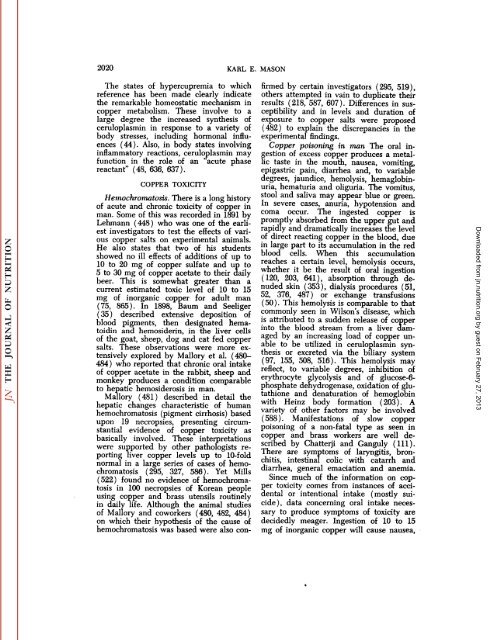conspectus of researchon copper metabolism and requirements
conspectus of researchon copper metabolism and requirements
conspectus of researchon copper metabolism and requirements
Create successful ePaper yourself
Turn your PDF publications into a flip-book with our unique Google optimized e-Paper software.
2020 KARL E. MASON<br />
The states <strong>of</strong> hypercupremia to which<br />
reference has been made clearly indicate<br />
the remarkable homeostatic mechanism in<br />
<strong>copper</strong> <strong>metabolism</strong>. These involve to a<br />
large degree the increased synthesis <strong>of</strong><br />
ceruloplasmin in response to a variety <strong>of</strong><br />
body stresses, including hormonal influ<br />
ences (44). Also, in body states involving<br />
inflammatory reactions, ceruloplasmin may<br />
function in the role <strong>of</strong> an "acute phase<br />
reactant" (48, 636, 637).<br />
COPPER TOXICITY<br />
Hemochromatosis. There is a long history<br />
<strong>of</strong> acute <strong>and</strong> chronic toxicity <strong>of</strong> <strong>copper</strong> in<br />
man. Some <strong>of</strong> this was recorded in 1891 by<br />
Lehmann (448) who was one <strong>of</strong> the earli<br />
est investigators to test the effects <strong>of</strong> vari<br />
ous <strong>copper</strong> salts on experimental animals.<br />
He also states that two <strong>of</strong> his students<br />
showed no ill effects <strong>of</strong> additions <strong>of</strong> up to<br />
10 to 20 mg <strong>of</strong> <strong>copper</strong> sulfate <strong>and</strong> up to<br />
5 to 30 mg <strong>of</strong> <strong>copper</strong> acetate to their daily<br />
beer. This is somewhat greater than a<br />
current estimated toxic level <strong>of</strong> 10 to 15<br />
mg <strong>of</strong> inorganic <strong>copper</strong> for adult man<br />
(75, 865). In 1898, Baum <strong>and</strong> Seeliger<br />
(35) described extensive deposition <strong>of</strong><br />
blood pigments, then designated hematoidin<br />
<strong>and</strong> hemosiderin, in the liver cells<br />
<strong>of</strong> the goat, sheep, dog <strong>and</strong> cat fed <strong>copper</strong><br />
salts. These observations were more ex<br />
tensively explored by Mallory et al. (480-<br />
484) who reported that chronic oral intake<br />
<strong>of</strong> <strong>copper</strong> acetate in the rabbit, sheep <strong>and</strong><br />
monkey produces a condition comparable<br />
to hepatic hemosiderosis in man.<br />
Mallory (481) described in detail the<br />
hepatic changes characteristic <strong>of</strong> human<br />
hemochromatosis (pigment cirrhosis) based<br />
upon 19 necropsies, presenting circum<br />
stantial evidence <strong>of</strong> <strong>copper</strong> toxicity as<br />
basically involved. These interpretations<br />
were supported by other pathologists re<br />
porting liver <strong>copper</strong> levels up to 10-fold<br />
normal in a large series <strong>of</strong> cases <strong>of</strong> hemo<br />
chromatosis (295, 327, 586). Yet Mills<br />
(522) found no evidence <strong>of</strong> hemochroma<br />
tosis in 100 necropsies <strong>of</strong> Korean people<br />
using <strong>copper</strong> <strong>and</strong> brass utensils routinely<br />
in daily life. Although the animal studies<br />
<strong>of</strong> Mallory <strong>and</strong> coworkers (480, 482, 484)<br />
on which their hypothesis <strong>of</strong> the cause <strong>of</strong><br />
hemochromatosis was based were also con<br />
firmed by certain investigators (295, 519),<br />
others attempted in vain to duplicate their<br />
results (218, 587, 607). Differences in sus<br />
ceptibility <strong>and</strong> in levels <strong>and</strong> duration <strong>of</strong><br />
exposure to <strong>copper</strong> salts were proposed<br />
(482) to explain the discrepancies in the<br />
experimental findings.<br />
Copper poisoning in man The oral in<br />
gestion <strong>of</strong> excess <strong>copper</strong> produces a metal<br />
lic taste in the mouth, nausea, vomiting,<br />
epigastric pain, diarrhea <strong>and</strong>, to variable<br />
degrees, jaundice, hemolysis, hemaglobinuria,<br />
hematuria <strong>and</strong> oliguria. The vomitus,<br />
stool <strong>and</strong> saliva may appear blue or green.<br />
In severe cases, anuria, hypotension <strong>and</strong><br />
coma occur. The ingested <strong>copper</strong> is<br />
promptly absorbed from the upper gut <strong>and</strong><br />
rapidly <strong>and</strong> dramatically increases the level<br />
<strong>of</strong> direct reacting <strong>copper</strong> in the blood, due<br />
in large part to its accumulation in the red<br />
blood cells. When this accumulation<br />
reaches a certain level, hemolysis occurs,<br />
whether it be the result <strong>of</strong> oral ingestion<br />
(120, 203, 641), absorption through de<br />
nuded skin (353), dialysis procedures (51,<br />
52, 376, 487) or exchange transfusions<br />
(50). This hemolysis is comparable to that<br />
commonly seen in Wilson's disease, which<br />
is attributed to a sudden release <strong>of</strong> <strong>copper</strong><br />
into the blood stream from a liver dam<br />
aged by an increasing load <strong>of</strong> <strong>copper</strong> un<br />
able to be utilized in ceruloplasmin syn<br />
thesis or excreted via the biliary system<br />
(97, 155, 508, 516). This hemolysis may<br />
reflect, to variable degrees, inhibition <strong>of</strong><br />
erythrocyte glycolysis <strong>and</strong> <strong>of</strong> glucose-6phosphate<br />
dehydrogenase, oxidation <strong>of</strong> glutathione<br />
<strong>and</strong> denaturation <strong>of</strong> hemoglobin<br />
with Heinz body formation (203). A<br />
variety <strong>of</strong> other factors may be involved<br />
(588). Manifestations <strong>of</strong> slow <strong>copper</strong><br />
poisoning <strong>of</strong> a non-fatal type as seen in<br />
<strong>copper</strong> <strong>and</strong> brass workers are well de<br />
scribed by Chatterji <strong>and</strong> Ganguly (111).<br />
There are symptoms <strong>of</strong> laryngitis, bron<br />
chitis, intestinal colic with catarrh <strong>and</strong><br />
diarrhea, general emaciation <strong>and</strong> anemia.<br />
Since much <strong>of</strong> the information on cop<br />
per toxicity comes from instances <strong>of</strong> acci<br />
dental or intentional intake (mostly sui<br />
cide), data concerning oral intake neces<br />
sary to produce symptoms <strong>of</strong> toxicity are<br />
decidedly meager. Ingestion <strong>of</strong> 10 to 15<br />
mg <strong>of</strong> inorganic <strong>copper</strong> will cause nausea,<br />
Downloaded from<br />
jn.nutrition.org<br />
by guest on February 27, 2013
















